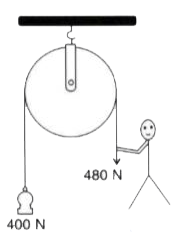Complete Solutions to EXAMPLES of chapter MACHINES of Class 10 book with complete answers and questions
| Class 10 | PHYSICS |
| Chapter | MACHINES |
| SELINA PUBLICATION | EXAMPLES |
| Number Of Questions | 14 |
| Academic Year | 2023-24 |
A machine is driven by a 100 kg mass that falls `8m` in `4*0`s. it lifts a load of mass 500 kg vertically upwards. Taking `g=10ms^(-2)`. Calculate:
(a) the force exerted by the falling mass.
(b) the work done by the falling mass in its displacement by `8*0`m.
(c) the power input to the machine.
(d) the power output of the machine if its efficiency is 60%, and
(e) the work done by the machine is `4*0`s.
View SolutionCalculate the ideal mechanical advantage of a lever in which the effort arm is 60 cm and the load arm is 4 cm.
View SolutionDraw a simple diagram ofa fire tongs and mark on it the fulcrum F and the points of application of load L and effort E. (a) Name the class of lever. (b) if load arm is 15 cm and effort arm is 5 cm. what is its mechanical adavantage?
View SolutionA crowbar 2 m long is pivoted about a point 10 cm from its tip.
(i) Calculate the mechanical advantage of the crowbar.
(ii) What is the least force which must be applied at the other end to displace a load of 100 kgf?
View SolutionA uniform seesaw, 5m long, is supported at its centre. A boy weighing 40 kgf sits at a distance of 1 m from the centre of the seesaw.
(i) To which class of lever does it belong ?
(ii) Find where a girl of weight 20 kgf must sit on the seesaw so as the balance the weight of the boy.
View SolutionA cook uses a fire tongs of length 28 cm to lift a piece of burning coal of mass 250 g. if he applies effort at a distance of 7 cm from the fulcrum, find the effort. Take g=`10ms^(-2)`.
View SolutionThe diagram below shows a lever in use.

(a) To which class of lever does it belong ? Give one example of this class.
(b) How will the mechanical advantage of lever change if load is shifted towards the fulcrum without changing it's dimensions.
View Solution(a) (i) State the principle of moments as applied to the lever shown in Figure. And
(ii) calculate its mechanical advantage if
`AB=2*0m and FA=20cm`.
(b) Calculate the effort needed to lift and load.
View SolutionA nut which can be broken by applying a force of 40 kgf, is broken by using a nut cracker having its handle 20 cm long, by placing it at a distance 2 cm from the hinge. Calculate the minimum force needed to break the nut.
View SolutionA man opens a nut by applying a force of 150 N by using a lever handle of length `0*4m`. What should be the length of the handle if he wants to open it by applying a force of 60 N?
View SolutionThe adjacent Figure shows a fixed pulley used by a boy to lift a load of 400 N through a vertical height of 5 m in 10 s. the effort applied by the boy on the other end of the rope is 480 N.

(a) What is the velocity ratio of the pulley ?
(b) What is the mechanical advantage ?
(c) Calculate the efficiency of the pully.
(d) Why is the efficiency of the pulley not 100% ?
(e) What is the energy gained by the load in 10 s?
(f) How much power was developed by the boy in raising the load ?
(g) The boy has to apply an effort which is greater than the load he is lifting. what is the justification for using the pulley ?
View SolutionThe diagram in Figure shows the combination of two pulleys `P_(1) and P_(2)` used to lift up a load W.
(a) State the kind of pulleys `P_(1) and P_(2)`.
(b) State the function of the pulley `P_(2)`.
(c) If the free end C of the string moves througha distance x, by what distance is the load W raised ?
(d) What effort E has to be applied at C to just raise the load W=20 kgf ? Neglect both the weight of the pulley `P_(1)` and friction.

View SolutionA pulley system with a velocity ratio of 4 is used to lift a load of 150 kgf through a vertical height of 20 m. the effort required is 50 kgf in downward direction. Calculate:
(a) the distance moved by the effort.
(b) the work done by the effort.
(c) the mechanical advantage.
(d) the efficiency of the pulley system, and
(e) the total number of pulleys and the number of pulleys in each block.
`(g=10N" "kg^(-1))`.
View SolutionA block and tackle has two pulleys in each block, with the tackle tied to the hook of the lower block and the effort being applied upwards.
(a) draw a neat diagram to show this arrangement and calculate its mechanical advantage.
(b) If the load moves up a distance x, by what distance will the fre end of the string move up ?
View Solution
EXAMPLES questions and complete solutions for chapter MACHINES of SELINA PHYSICS (ENGLISH) of Class 10